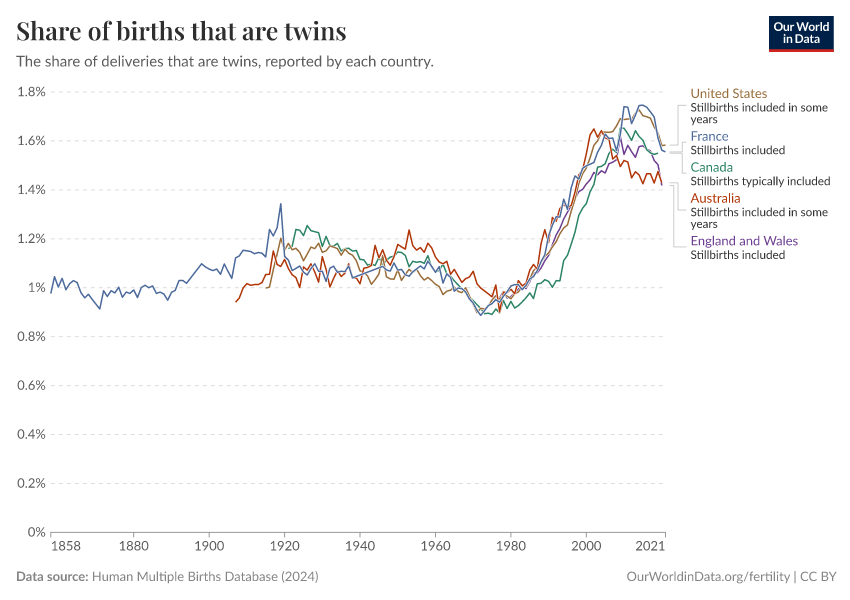Share of births that are twins

What you should know about this indicator
- Twin births have risen dramatically since the 1980s. One reason is the use of reproductive technologies such as in vitro fertilization (IVF), which have made it possible for many more couples to conceive. During procedures like IVF, multiple eggs can be used at the same time to maximize the chances of a successful pregnancy, which can lead to twin births.
- Another reason for the rise in twin births is that the average age of women at childbirth has risen. Older women are more likely to have twin births, even without using reproductive technologies.
- In some countries, twin birth rates have dropped in recent decades, as reproductive technologies have shifted to using single-embryo transfers instead of multiple.
What you should know about this indicator
- Twin births have risen dramatically since the 1980s. One reason is the use of reproductive technologies such as in vitro fertilization (IVF), which have made it possible for many more couples to conceive. During procedures like IVF, multiple eggs can be used at the same time to maximize the chances of a successful pregnancy, which can lead to twin births.
- Another reason for the rise in twin births is that the average age of women at childbirth has risen. Older women are more likely to have twin births, even without using reproductive technologies.
- In some countries, twin birth rates have dropped in recent decades, as reproductive technologies have shifted to using single-embryo transfers instead of multiple.
Sources and processing
This data is based on the following sources
How we process data at Our World in Data
All data and visualizations on Our World in Data rely on data sourced from one or several original data providers. Preparing this original data involves several processing steps. Depending on the data, this can include standardizing country names and world region definitions, converting units, calculating derived indicators such as per capita measures, as well as adding or adapting metadata such as the name or the description given to an indicator.
At the link below you can find a detailed description of the structure of our data pipeline, including links to all the code used to prepare data across Our World in Data.
Notes on our processing step for this indicator
Data sometimes includes stillbirths, therefore comparability across countries should be done with care.
Countries including stillbirths: Czech Republic, Denmark, England and Wales, France, Greece, Italy, Lithuania, Netherlands, Norway, Spain, Sweden, Switzerland
Countries mostly including stillbirths: Austria (unknown for 1920, 1921, 1928, 1929, 1931, 1934), Canada (unknown for 1921-1925, 1927-1990), Finland (unknown for 1906-1936, 1941-1999), Germany (unknown for 1906-1936), Japan (unknown for 1923-1936)
Countries excluding stillbirths: Chile, South Korea
Countries with mixed practices: Australia, New Zealand (excluded for 1856-1915), United States, Scotland (excluded for 1856-1938), Uruguay
For more details about the data for a specific country, please refer to the original source.
Reuse this work
- All data produced by third-party providers and made available by Our World in Data are subject to the license terms from the original providers. Our work would not be possible without the data providers we rely on, so we ask you to always cite them appropriately (see below). This is crucial to allow data providers to continue doing their work, enhancing, maintaining and updating valuable data.
- All data, visualizations, and code produced by Our World in Data are completely open access under the Creative Commons BY license. You have the permission to use, distribute, and reproduce these in any medium, provided the source and authors are credited.
Citations
How to cite this page
To cite this page overall, including any descriptions, FAQs or explanations of the data authored by Our World in Data, please use the following citation:
“Data Page: Share of births that are twins”, part of the following publication: Saloni Dattani, Lucas Rodés-Guirao, and Max Roser (2025) - “Fertility Rate”. Data adapted from Human Multiple Births Database. Retrieved from https://archive.ourworldindata.org/20250909-093708/grapher/rate-of-twin-deliveries.html [online resource] (archived on September 9, 2025).How to cite this data
In-line citationIf you have limited space (e.g. in data visualizations), you can use this abbreviated in-line citation:
Human Multiple Births Database (2024) – processed by Our World in DataFull citation
Human Multiple Births Database (2024) – processed by Our World in Data. “Share of births that are twins” [dataset]. Human Multiple Births Database, “Human Multiple Births Database v.1” [original data]. Retrieved December 5, 2025 from https://archive.ourworldindata.org/20250909-093708/grapher/rate-of-twin-deliveries.html (archived on September 9, 2025).